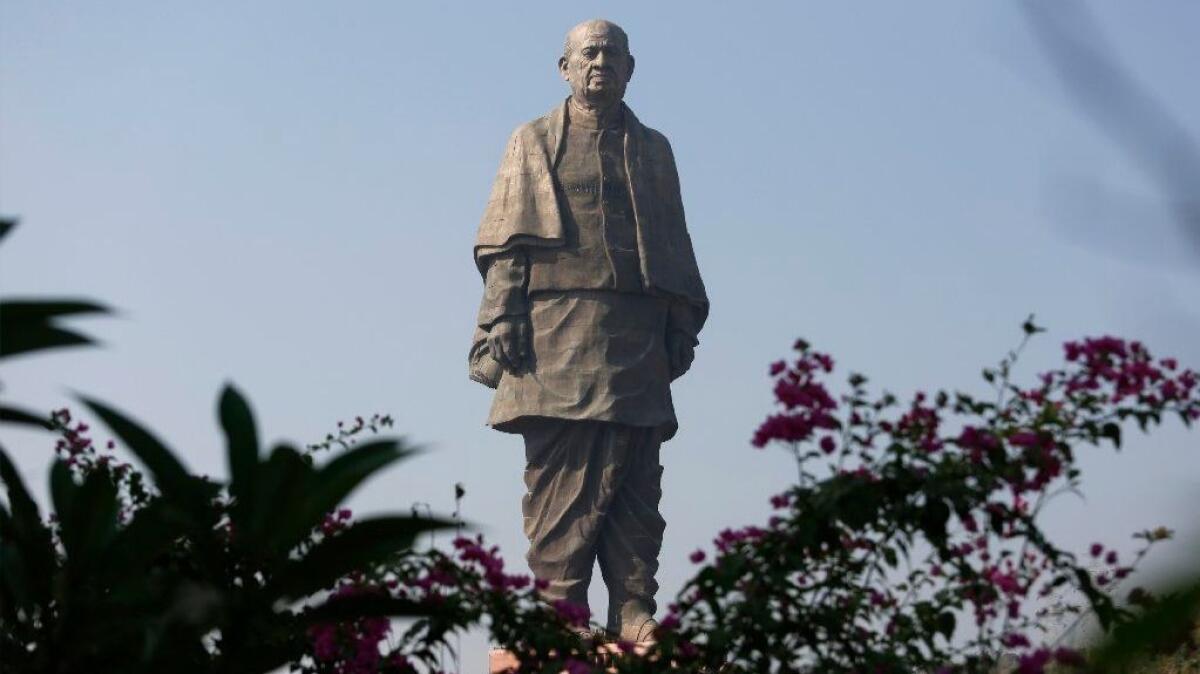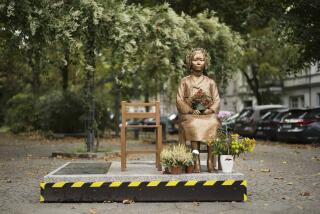Back Story: India just unveiled the world’s tallest statue. Who is he?

- Share via
Reporting from New Delhi — India on Wednesday unveiled the world’s tallest statue – a 597-foot bronze likeness of Sardar Vallabhbhai Patel, an independence movement leader who later served as the country’s first deputy prime minister.
In a ceremony on a riverbank in western India marked by air force flyovers and dance troupes, Prime Minister Narendra Modi paid tribute to Patel on what was the 143rd anniversary of his birth.
Patel is a staple of Indian history books, though he isn’t as well-known outside the country as such independence icons as Mahatma Gandhi and Jawaharlal Nehru, the first prime minister. But the statue has nevertheless stirred controversy as India’s Hindu nationalist leaders tussle over Patel’s legacy.
Here’s a look at India’s newest monument and the issues it has engendered:
What is the statue?
At nearly 600 feet, the monument known as the Statue of Unity is about twice the height of the Statue of Liberty and easily surpasses the 420-foot Spring Temple Buddha, previously the world’s tallest, in Henan, China.
It stands on a remote coastal bank of the Narmada River in Gujarat, the home to both Patel and Modi.
Cast from roughly 1,700 tons of bronze, the statue depicts Patel standing erect and staring into the heavens while garbed in a traditional shawl and vest over a thigh-length kurta. A government drive collected 135 tons of scrap iron from farmers to help build the interior.
How much did it cost?
India has spent $430 million over 42 months to build what it calls the world’s grandest statue. Two high-speed elevators reach a viewing gallery that can hold up to 200 people – and includes (naturally) a selfie point.
The area around it is being developed into a tourist zone with a museum, hotels, restaurants and a research center focused on agricultural development, one of Patel’s passions. The statue can reportedly withstand a magnitude-6.5 earthquake.
What were Patel’s accomplishments?
Born to a farming family in 1875, Patel, after working to help India gain independence from Britain in 1947, helped persuade the rulers of 565 semiautonomous princely states to join the new nation. He did so with a mix of diplomacy and threats of armed action.
Commonly hailed as the Iron Man of India, he held two important positions in India’s first government – deputy prime minister and minister of home affairs – before his death in 1950.
Why are India’s leaders fighting over his legacy?
Patel, along with Nehru, was a leader of the Indian National Congress, which led the independence drive against British colonial rule and became a political party. The Congress party is the chief rival to Modi’s ruling Bharatiya Janata Party, which has been going all-out to appropriate Patel’s legacy and weaken the Congress party ahead of national elections next year.
Hindu nationalist Modi and his allies accuse the Congress party of ignoring Patel’s contribution to the nation while favoring the Nehru dynasty, which included two subsequent prime ministers, Nehru’s daughter Indira Gandhi and grandson Rajiv Gandhi. Nehru’s great-grandson, Rahul Gandhi, is the Congress party’s current president.
Critics say the memorial to Patel is the BJP’s attempt to undermine the liberal, secular Nehru as well as claim a piece of the Congress-led freedom struggle.
Taking a dig at Nehru, Modi said in a speech this year that had Patel been India’s first prime minister, India would not have lost control of part of the disputed state of Kashmir to archenemy Pakistan.
What do opponents say?
Modi’s rivals point out that Patel banned the Rashtriya Swayamsevak Sangh, a hard-line Hindu organization that is the BJP’s ideological parent, in 1948 after Mahatma Gandhi was assassinated. Gandhi’s killer was Nathuram Godse, a Hindu nationalist and former member of the Hindu group who objected to Gandhi’s conciliatory approach toward India’s Muslim minority.
The ban was later lifted, and the organization was never directly implicated in Gandhi’s killing.
Patel isn’t the only icon being claimed by the BJP. The party’s state government in Maharashtra is planning an even taller statue of Shivaji, a 17th century Hindu king who fought Muslim Mughal rulers in western India, off the coast of Mumbai.
How does the cost compare to other Indian programs?
The Patel statue has been criticized as an extravagant waste of public money in a country that rates consistently low in healthcare and education indices.
It cost 10 times as much as the Modi government’s much-touted “Save the Girl Child” program to promote female education.
The statue triggered further scrutiny when state-owned oil companies disclosed that they had contributed more than $16 million to the project in 2017 from public funds earmarked for social programs.
How has the statue become a political issue?
In recent weeks, protests marred the statue’s opening as members of indigenous tribal communities complained they were displaced from their villages without adequate compensation.
Reports estimate that more 75,000 people from 72 villages were forced to move so that the statue could be built. While officials say they were compensated for the land, some villagers have protested, saying the amounts were insufficient.
On the eve of the unveiling, activists said about 90 people were detained on suspicion of planning to protest at the site, then later released.
The Congress party further criticized the government for importing some of the bronze from China and reportedly hiring a Chinese construction subcontractor.
They said it flew in the face of one of Modi’s pet programs, dubbed “Make in India,” which aims to encourage entrepreneurship and manufacturing.
The government has dismissed such concerns. In 2014, when it first allotted funds for the statue, a law minister said: “We are proud of the legacy of Sardar Patel…. Why should there only be statues of Nehru and Indira Gandhi?”
Masih is a special correspondent.
More to Read
Sign up for Essential California
The most important California stories and recommendations in your inbox every morning.
You may occasionally receive promotional content from the Los Angeles Times.










